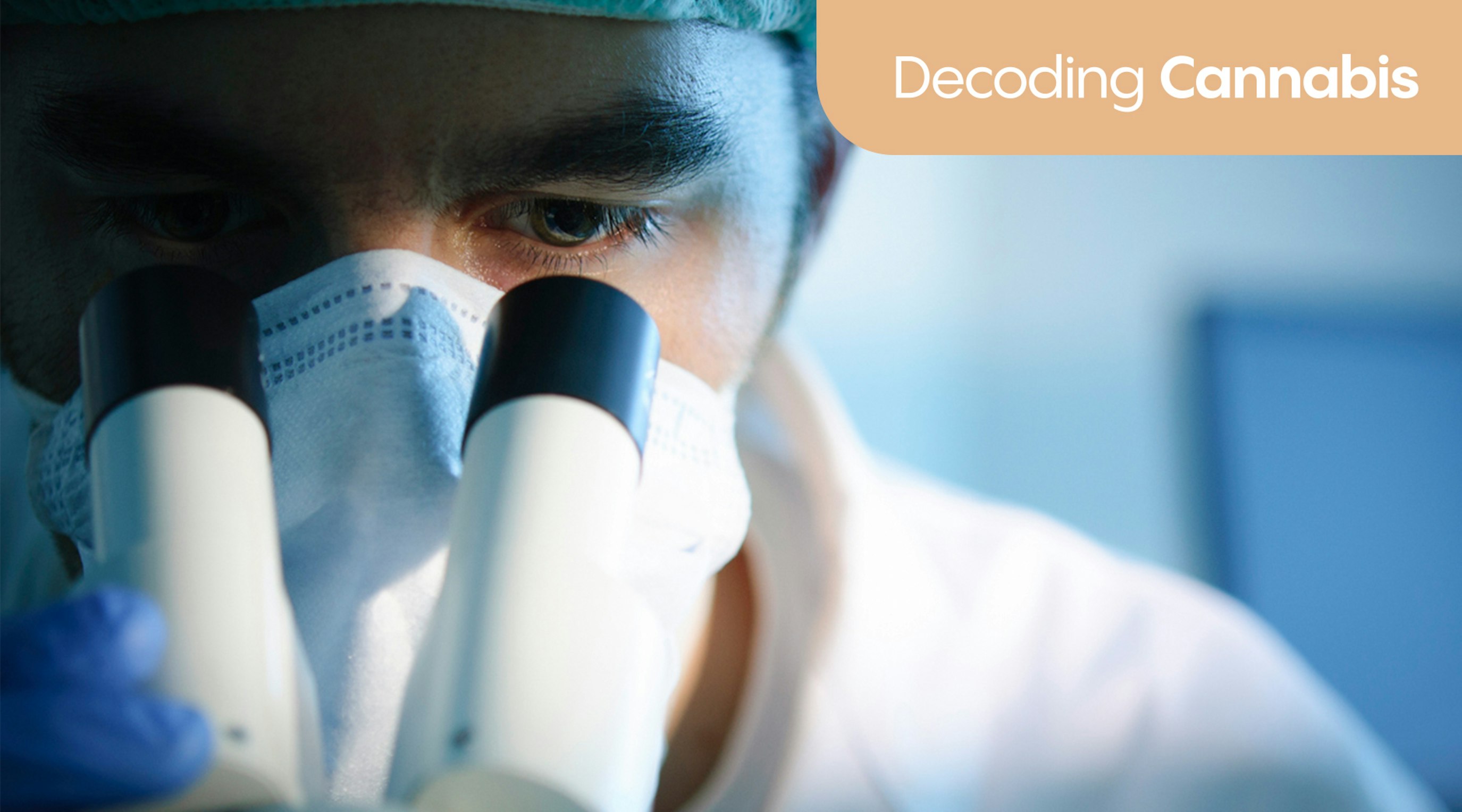Decoding Cannabis: The science behind oral CBD absorption and bioavailability
8 min read
Sam North
Taking CBD (or cannabidiol) feels simple enough. A few drops in the morning to start the day fresh, a capsule after lunch to clear the fog, or a gummy before bed to help you drift off.
But behind that ease lies a quiet, sometimes overlooked, but also very important question:
“How much of that oral CBD is actually being absorbed?”
The answer - less than you think.
Contents
In today’s first full instalment of our new series, Decoding Cannabis (where we break down key medical cannabis research in clear, accessible terms), we’re going to answer the above question using pure scientific data.
The paper we’re decoding is “Optimising Cannabidiol Delivery: Improving Water Solubility and Permeability Through Phospholipid Complexation” - a preclinical formulation study, meaning it was conducted in the lab, not using human or animal subjects.
And while that title is quite a mouthful (and the paper isn’t exactly bedtime reading), it offers sharp insight into a fundamental challenge in oral CBD application: bioavailability, or how much CBD your body can actually absorb and use - and how researchers are working to improve it.
How much orally administered CBD is absorbed by your body?
Think of oral CBD like water poured onto a dry sponge. You’d expect it to sink in, to be drawn into every pore. Instead, most of it slips off the sponge and straight down the drain.
That’s how CBD behaves in the body, especially when it is taken orally and into the digestive system.
Why bioavailability matters
Let’s say you swallow 20 mg of CBD in an oil or capsule. If that product has a bioavailability of just 6% (a common figure for oral CBD), only around 1.2 mg is actually reaching your bloodstream. The rest is lost - either degraded by stomach acid, broken down by enzymes, or flushed out by the liver before it can do anything useful.
This gap between dose and effect is one of the biggest reasons people struggle to find consistent results with oral CBD. And it’s precisely the problem the researchers in this study were trying to address.
Is swallowing CBD the most effective option?
No - in fact, it’s at the bottom of the list. Oral CBD is popular because it’s convenient - but if you want to get the most out of your CBD administration, then other routes are far more efficient.
- Sublingual CBD (drops held under the tongue) has been shown to have a bioavailability of 12 to 35%, and effects are usually felt within 15 to 30 minutes.
- Inhaled CBD (through vaping either CBD flower or CBD oil) is thought to be most efficient, with an average bioavailability of around 31% and effects kicking in around the 10 minute mark.
Of course, each method comes with its own pros and cons - sublingual is discreet and easy to dose, while inhalation is faster but not always suitable for everyone. Still, it’s clear that the way you take CBD matters. And for those relying on oils, capsules or edibles, the numbers show there’s room for improvement.
What about taking CBD with food?
The study we’re focusing on didn’t explore the impact of food - but it’s worth pausing on it briefly.
Because CBD dissolves in fat, there’s evidence from other research that taking it alongside a meal, particularly one containing healthy fats, can help your body absorb more of it. It’s not a silver bullet, but it can make a difference.
So if you’re using oral CBD, timing it with food might be one small way to improve its effect - at least until more advanced formulations do a better job for you.
Now, back to the lab.
What problem were the researchers trying to solve with CBD absorption?
In 2025, CBD is anything but new. The majority of the wider public in the UK know what it is (or has at least heard of it) - but from a pharmaceutical perspective, it’s a little awkward to work with. It doesn’t dissolve well in water, and it struggles to pass through the intestinal lining. And, that’s a problem if you’re trying to get it into the bloodstream in any reliable way.
The researchers behind this study were focused on a solution that could tackle all three issues at once: poor solubility, instability, and low permeability. Their approach was to create something called a CBD-phospholipid complex, or CBD-PLC.
What do we mean by a CBD-phospholipid complex?
A ‘complex’, in this context, is simply a stable molecular pairing - CBD bound to phospholipids, which are fat-like molecules found in every cell membrane. These are often used in drug delivery because they help substances move through biological barriers, like the lining of the gut.
The idea is that by forming a stable complex, CBD might behave less like an oily supplement and more like a compound the body can absorb and use effectively.
The goal wasn’t just to improve absorption: it was to create a form of CBD that’s also more stable, more predictable, and, ultimately, better suited to medical use.
How did the researchers test the CBD-phospholipid complex?
To create the complex, the team combined CBD extract with soy lecithin, a natural source of phospholipids. They aimed to encourage the two substances to bind into a more stable form. The result was a solid formulation referred to as CBD-PLC (most likely a powder, though the paper doesn’t state this explicitly).
They then ran a series of lab tests to compare this new formulation with two others - a standard CBD extract and a basic physical mixture of CBD and lecithin. The question was whether the complex really did change how CBD behaved, or if it was no more effective than regular CBD extract or simply mixing CBD with the lecithin.
The researchers focused on three key properties:
- Dissolution: how well the CBD dissolves in fluid
- Permeability: how easily it passes through a gut-cell model (Caco-2 cells)
- Stability: whether the formulation holds up over time under standard storage conditions
The results were very clear.
What did the study show us?
The researchers found that the CBD-phospholipid complex outperformed both the raw extract and the simple mixture across all three tests. In short, the way the CBD was formulated had a measurable effect on how it behaved.m
Dissolution - How well the CBD dissolved
In fluid designed to mimic conditions in the gut, the complex released 67% of its CBD within three hours. The raw extract, by contrast, released none.
This matters because if CBD can’t dissolve, it can’t be absorbed. It simply passes through the digestive system unused.
Permeability - How easily the CBD was absorbed
When tested in a lab-grown model of the intestinal wall (Caco-2 cells), the complex showed significantly better permeability than the other two formulations - nearly double in some cases.
That suggests it may be more effective at crossing into the bloodstream, though this still needs to be tested in humans.
Stability - How well the CBD held up over time
This was another win. After 12 months in storage, the complex showed no significant breakdown of CBD.
For any product designed for medical use, this kind of long-term stability is essential.
What does this mean if you're using CBD oil or capsules (or any oral CBD product)?
This was a lab study, not a clinical trial, so we can’t say exactly how this formulation would behave in the body.
But the results are promising.
With the right formulation, oral CBD could become more predictable and more effective.
This study doesn’t solve the problem outright. But it offers a clear step forward, and a glimpse of where things are heading: better absorption, more consistency, and CBD products designed to work with the body, not against it.
Hopefully, in the not too distant future, we will be able to break down a study that follows on from these findings involving human participants.
Want to know which CBD or medical cannabis format might work best for you?
Whether you're considering over-the-counter CBD or exploring a medical cannabis prescription, formulation matters. Releaf’s world-class clinical team can help you understand what your body is likely to absorb and how different formats compare in real-world use.
Through our partnership with SOMAÍ Pharmaceuticals, Releaf patients have access to a range of high-quality prescribed cannabis oils, manufactured in a GMP-certified facility for consistency and reliability.
You can also explore our UK CBD Shop, where every product is selected with absorption, stability and quality in mind.
If you’re interested in finding out whether you might be eligible for a UK medical cannabis prescription, head to our fast, free medical cannabis eligibility checker. It takes less than 20 seconds to complete and could be the first step toward better health outcomes and a more stable quality of life.
Share article
Did you like this article?
It is important to seek medical advice before starting any new treatments. The patient advisors at Releaf are available to provide expert advice and support. Alternatively, click here to book a consultation with one of our specialist doctors.
Elevate your wellness with medical cannabis
Get comprehensive care, convenience, and confidence with an all-in-one treatment plan.
Am I eligible?Authors
Sam North, a seasoned writer with over five years' experience and expertise in medicinal cannabis, brings clarity to complex concepts, focusing on education and informed use.
Editorial Policy
All of our articles are written by medical cannabis experts, guided by strict sourcing guidelines, and reference peer-reviewed studies and credible academic research. Our expert clinical team and compliance specialists provide valuable insights to ensure accuracy when required. Learn more in our editorial policy.
Need more help?










